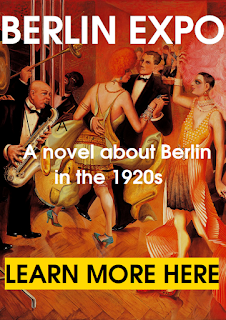“Resi”
was short for a vast, luxurious dance-hall called Residenz-Casino, just
by Alexanderplatz. It was built and opened in 1908, but it was in the Weimar Period
that the venue really came into its own.
 |
| "Resi bleibt Resi" (Resi
will always be Resi). Behind those four letters there was a Berlin
institution famous all across Europe |
  |
| In the 1920s |
The dance-floor could accomodate 1000 people and its ceiling was made from reflective glass. There were several bars and private rooms, but its most talked about feature were 200 private telephones fixed to tables and various stations around the venue, where customers could flirt anonymously with other patrons. A lamp on the table gave an indication of the availabilty of each guest: if the light was red, that meant "Go ahead", while blue meant "Don't disturb". Guests could also choose from a menu of 135 gift items and have them sent to other patrons via pneumatic delivery tubes (Rohrpoststation) suspended above the tables. Supposedly, little packets of cocaine were also sent through those tubes...
 |
| Resi in 1952 |
 |
| At Resi in 1936 |
 |
| In the 20s |
A rain of confetti
all over the place, over you, over me. That’s the famous Confetti
Dance of Resi, which the whole world has tried to imitate. To run
the light and water marvels of Resi, a whole power station is
needed ; it is lodged in the cellar of the building, together
with the soul of Resi’s telephone system. Because Resi was the
first dance hall to introduce the table Ttlephones. At every table, a
device to speak and to listen with. A red lamp lights up :
someone wants to talk with you. You take the handset to your ear and
you hear a friendly lady voice asking if you would care for a dance.
There are another three signals : "Gentleman dancer
wanted", "Lady dancer wanted" and "Don’t
disturb please".
Here, a colourful description of Resi by Mel Gordon:
"The Resi offered another kind of diversion. It was an interactive pickup bar-cum-wired nightclub. Designed in another monstrous Baroque style, Montmartre Music Hall crossed with UFA spaceship, the Resi sported several tiers of dining, dancing, and infantile play. One of its many ceilings was a motorized glass dome, painted with images of squawking birds and exotic flora. Mechanical geysers erupted with three-foot streams of sparkling, dyed water and 100 mirrored-balls continuously revolved and then split open, like welcoming orchids, when the overhead lights went down. There was a downstairs private rendezvous wine-room, competing bands and bar counters, a parquet dance floor for one thousand box-steppers, even a gigantic “Carousel and Shooting Gallery” for drunken revelers, attempting to relive adolescent Luna Park memories.
Mostly patrons came to the Resi for its promiscuous atmosphere and helpful technology. On 150 tables and 50 balcony stations, numbered telephones allowed celebrants to dial up complete strangers from across the palace and converse in naughty word-play or whisper instructions which bar to meet at. Additionally, an ingenious pneumatic system, built into the Resi handrailings, allowed guests to send small goodies to potential comrades-of-the-evening. On request, waiters brought gift-menus. Lovestruck customers selected from a list of 135 pocket-sized presents, like a bottle of perfume, cigar-cutter, or travel plan for a secret weekend (encased in leather). The luxury item was then placed in a sealed container, rocketed through hidden pneumatic tubes, and finally landed with a dramatic whoosh in a basket at the edge of the intended’s table.
Resi flyers assured the nocturnal public that this was “Berlin at its most beautiful.” The institution outlasted Weimar and became a favorite attraction during the 1936 Nazi Olympics. Allied bombers smothered its randy charms in a devastating nighttime raid in 1944. The last Pleasure-Palace of Berlin finally imploded."
(From "Voluptuous panic. The erotic world of Weimar Berlin", by Mel Gordon)
And here, a description in John Chancellor's tourist guide "How to be happy in Berlin", 1929:





































